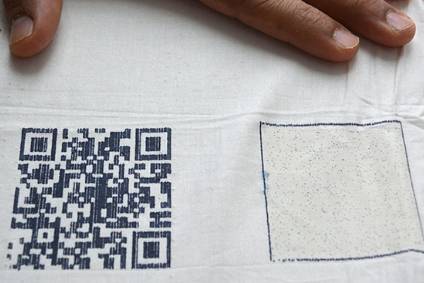
Researchers at Sweden’s University of Boras say they have developed a new secure system to tackle the challenge of traceability in the global textiles and clothing supply chain.
Information asymmetry, counterfeits and lack of transparency and traceability are currently being tackled using QR codes and RFID chips – but they are easy to copy.

Discover B2B Marketing That Performs
Combine business intelligence and editorial excellence to reach engaged professionals across 36 leading media platforms.
Instead, Tarun Kumar Agrawal, a doctoral student in textile management at the Swedish School of Textiles, has come up with a solution at the product level that involves a unique cryptotag printed on the garment.
“The textile supply chain is a complex network and a lot can happen in the process between the various production lines or stages – from the production of fibre and yarn and on to weaving or knitting the textile, the garment production, the transportation to the retailers, and finally to the consumer,” he explains.
“Moreover, consumers want to know where the garment they buy comes from, what it is made of, and if it is ethically produced. At the same time, the producers want to show that their products keep promised quality and are sustainable, and they want to be able to protect themselves from counterfeiting.”
The new cryptotag printed on the garment contains tiny particles that randomly form a unique pattern. By image reading, it is possible to identify these patterns, similar to when identifying a fingerprint. The new traceability system then connects data to the tag.

US Tariffs are shifting - will you react or anticipate?
Don’t let policy changes catch you off guard. Stay proactive with real-time data and expert analysis.
By GlobalDataAt the information level, the traceability system has been developed to be completely open, so that the stakeholders who are connected to it can follow what is happening, from the production of raw material to finished garment, and further out to the customer, through the entire supply chain.
The tag has been developed and tested at lab scale and is said to show promising results on durability, washability, abrasion resistance and stretchability.
“It is important that the tag is durable and that the particles that form the unique pattern can be read off,” says Agrawal. “This is also important when the garment is worn out and goes to recycling, in order to be able to deduce what material the textile consists of, for example, if it is pure or mixed material.
“The system lacks central authority, which means that there is no individual party that owns and verifies the information transfer. Instead, so-called blockchain technology has been used, which is the same technology behind virtual currency transactions, such as bitcoin, to make the information transfer secure. This reduces the risk of the information being manipulated by one single party.
“Since the system is open to all connected stakeholders, they can follow the production process all the way. The technology helps to develop a technology-based trust among the stakeholders. And the customer can further know the history of the garment using the system,” he says.
Agrawal says the next stage is to scale up the system, improve the algorithm that has been used, and work with companies to try and test it in their supply chains.
“Investing in the infrastructure is crucial for the industry to implement sustainable development, as well as taking responsibility for production and consumption. With control and transparency of the supply chain for the production of textiles and garments, it will also be possible to actualise reduced climate impact. Global partnerships are the main key in the work for sustainable development.”





